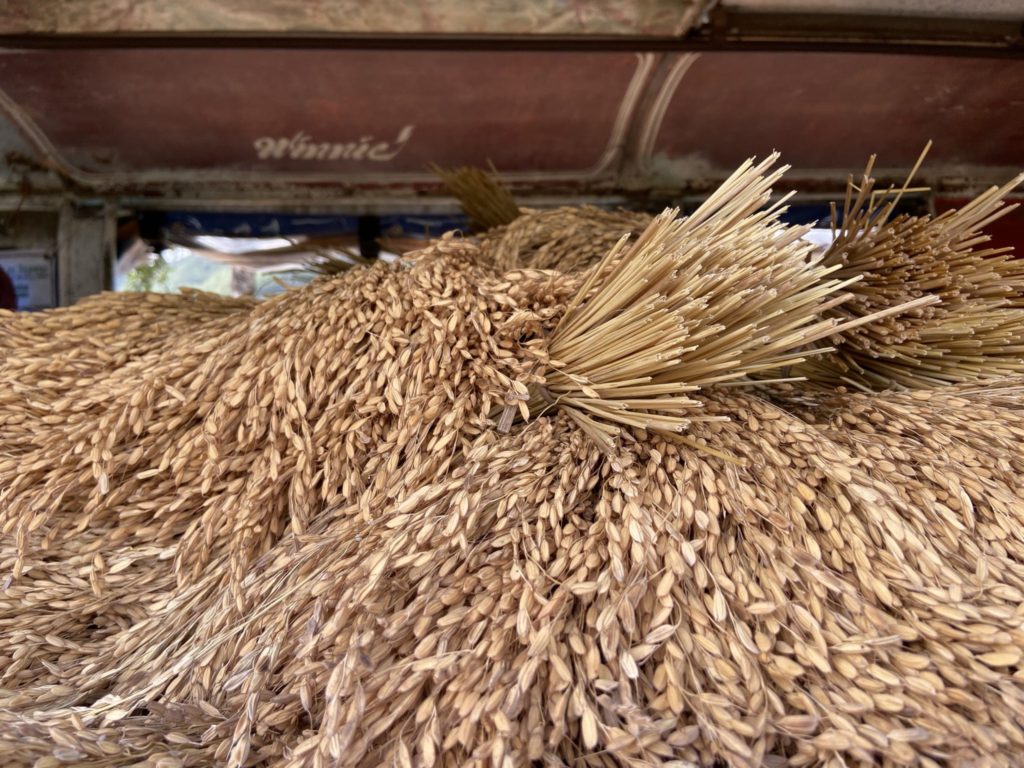
There’s a classic Filipino song / jingle we were taught as a kid:
“Magtanim ay di biro ( Planting is no joke)
Maghapong nakayuko (Bent all day long )
Di man lang makaupo ( You can’t really sit)
Di man lang makatayo ( You can’t really stand)”
It goes on to sing about the many, many body aches you get when planting (arms, waist/hips, legs) and ends with a quick encouragement to stretch before you start your long day ahead. It’s a hard-knock life.
Growing up, when a student does badly in school, it’s not uncommon to hear a frustrated parent say, “Send him/her to the farm. Then he/she will see a tough life. Let’s see if he won’t learn his lesson.” Is it the ultimate punishment?
When you think about it, all that work-hard motivational speech/formula we love to pass down to the next generation ends here — because after all your hard work and effort, during harvest time, you are still at the mercy of nature.
Amazing isn’t it, to take a step back, and realize that the very people who till the land for the most basic human need — food — actually shoulders a big part of the risk for us?
The Philippines is the 8th largest producer of rice in the world. Small rice farmers on average earn about 150-250 pesos a day ($3-$5) – if nature cooperates. When you walk around the restaurants in Manila you’ll find dozens offering “Unlimited Rice” AKA eat-all-you-can rice AKA “rice is life.” The Rice Terraces of the Philippine Cordilleras have been on the UNESCO World Heritage List since 1995.
Throughout the years, I’ve often heard people say, “The eighth wonder is slowly dying. The rice terraces are endangered.” Since these terraces were carved into the mountains by indigenous people (probably with very little equipment and mostly by hand), constant reconstruction and care are crucial. But who would still want to farm?
My generation sings (and were taught to sing) — planting rice is no joke!
From Manila, we took the bus to Banaue (about 10 hours) armed with only an excel file with recommendations from my cousin’s friend who’s been there before. For accommodation, I called a homestay in Bontoc, a town another 2 hours from Banaue. Ma’am Suzette (owner) picks up, “Yes, I can reserve a room. There’s no signal in most areas so make sure to send me a text when you get to the city center. Don’t worry we can figure out an itinerary when you get here. Budget about 800-1,500 pesos for your tour guide for 2 days. Yes, that’s for all 3 of you in your group.”
I call her again, from Manila, a few hours before leaving, “Do I need hiking shoes? I only have sneakers.” “You’re better off if you have shoes with teeth,” she says.
I think that is the perfect way to describe the Rice Terraces, a destination with teeth.
Life is still simple here, like the technological advancement of the last decade has arrived but in very slow motion. You can find homestays but with only the most basic amenities. Yet, make no mistake and call it boring.
Everywhere you look nature calls out to you — inviting you to sink your teeth (shoes?) into her.
And often, you have no choice but to do so.
But then if you’re really willing, nature will interact and challenge you one-hundred-one ways.
Walk: the zigzagging up-down-up-down road to the homestays; the endless edges of the rice-terraces; the unmarked path to the nearby mountains; the long journey to the hot springs; the life of the farmer who still does everything by hand.
You can run, of course, but speed here seems unnecessary. Oh, after your walks, you can bathe in the falls, go explore caves, hike the mountains at sunrise or sunset, ride on top of a jeepney while staring at the sun and moon during the daytime, watch traditional dishes be cooked, scream at bugs and spiders living their life while you try to live yours… or like Thanos, just sit down and stare.
This is one of the places I’d love to not talk about because it still feels like a secret. Compared to some destinations I’ve been to, the scale of tourism here is still pretty small. And yet a part of me, that human part that loves to talk about things worthy of attention, feels like it needs to be seen more by people who care enough to make that long off-beat journey.
How will it look like in a few years? Most farmers only plant in the rice terraces once a year, harvest here is May/June — so in December when my friends and I went — the very few farmers that we saw were starting to till and prepare the soil for the next season. They were mostly women.
Where are the men? How do they earn money during that time? One of our tour guides is a farmer. He also gets money by carrying goods up and down houses/restaurants built among the terraces. Commission based on tourism (recommendations on accommodation, transportation, etc) is another way. Interestingly enough, all these alternative tourism jobs probably earn more than the actual farming, with fewer body aches and in a way a lot less risk. But the rice terraces bring the tourist, and tourism brings the money.
And we still live in an age where the people providing the most basic of human needs find it hard to survive or sustain a family by doing just that…
Planting is no joke.









